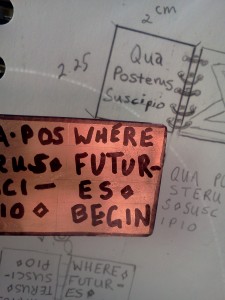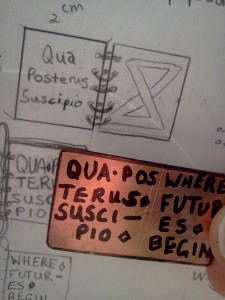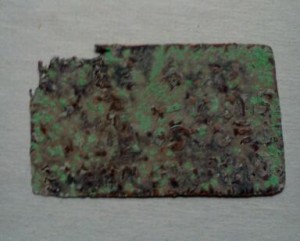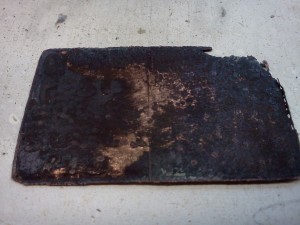Continuing with my goal of making useful jewelry mechanisms, I have decided to make a series of lockets. One of them is going to be donated to the annual PTA Silent Auction at a local school, and that is the one I have chosen to start with.
Historically the school’s motto has been “Qua Posterus Suscipio,” but in recent years it has been replaced by it’s English equivalent, “Where Futures Begin.”
 I love Latin and wanted to honor our school’s nod to the classics in my work. Plus, the theme of the auction that I am making this piece for is the Middle Ages. My design for this locket is to etch the Latin motto on one side and English on the other.
I love Latin and wanted to honor our school’s nod to the classics in my work. Plus, the theme of the auction that I am making this piece for is the Middle Ages. My design for this locket is to etch the Latin motto on one side and English on the other.
The words in the English version are all roughly the same length and I only had to break the word futures across two lines. However, the Latin word for where is only three letters long and while the remaining two words have the same number of characters, they were both too long to fit on one line.
I decided that four lines of text would look the best. I tried a few different versions of how to break the words up. I think the one I like the best reads “QUA*POS-TERUS*SUSCI-PIO.
These copper pieces are larger than the 2×2.5 cm as pictured. I left a little around the outside for making a crisp border. I ended up preparing three Latin versions and one in English. The copper shown here is prepped with resist, a.k.a permanent marker. Any areas not covered with resist will get etched with ferric chloride.
Tomorrow I will be placing this piece in a pyrex dish with some P.C.B. (printed circuit board etchant) from Radio Shack. I’ll leave it in the acid bath for up to 24 hours, checking every few hours to see how deep the etch is. Since the piece is double sided, I’ll have to make something to suspend the piece in the solution rather than letting it sit on the bottom of the dish.
Qua Posterus liqueslicui…dilabrio…diluo…distraho*…liquefacio**
Well I underestimated the effect that the heat from the boiler room would have on the etchant. It was timed on much cooler temperatures and stayed in the acid bath a little too long.
I cleaned it up a bit, but stopped short of polishing it in the tumbler, mainly because the edges were frail and crumbly. Left untreated it quickly developed verdigris, but only on one side.
Etched pieces are hard to store, even if finished. This one will be sent to the leper colony of failed copper experiments that I keep at the bottom of the copper drawer.
I also have a pie plate full of dried etchant and copper crud. It was liquid for a while, now it is growing crystals. Like countless generations before me, I now have toxic waste to dispose of. There was another piece in with this, but it completely dissolved.
How do you say, “Back to the old drawing board,” in Latin?
*My favorite…distraxi
**this is probably the most accurate term to describe how the etchant turned solid copper into slurry.


